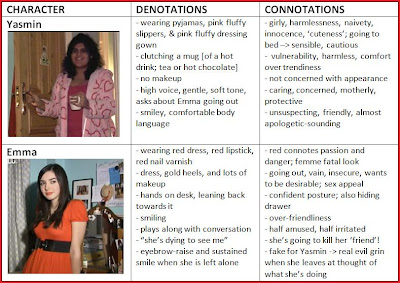Our film opening shows a young, white female, and an Asian female of about the same age. They appear to be sharing quite a nice house – the mise-en-scène indicates that they are mi
 ddle-class, and are students aged around 19-20 years old. One piece of audience feedback we got from our screening was that our opening reminded them of the film Single White Female (Barbet Schroeder, 1992), as it focuses around two women sharing an apartment, one of whom has psychological issues.
ddle-class, and are students aged around 19-20 years old. One piece of audience feedback we got from our screening was that our opening reminded them of the film Single White Female (Barbet Schroeder, 1992), as it focuses around two women sharing an apartment, one of whom has psychological issues.We represent two quite different female characters, who seem to possess some of the stereotypical characteristics associated with girls and women. However, they represent two different stereotypes of females, and have very different personalities, demonstrating Levi-Strauss' theory of binary oppositions.

Emma, the antagonist of our film, cares a lot about the way she looks, and is very insecure, aspiring to be like the models she sees in magazines. We reflected this with our careful choice of mise-en-scène; she has an enormous mirror on her desk, and around the frame of the mirror are stuck many pictures showing beautiful people, cut out of magazines. On the desk you can see a great deal of make-up, hair products, and perfume. When the drawer is opened, you can see typical ‘girly’ items, like nail varnish and ‘cute’ things, as well as an iPod, as other students would have, and Oscar Wilde’s The Picture of Dorian Gray – we thought this was rather fitting subtle addition as it is a book that focuses on beauty and aesthetics. These also add to the representation of a middle class, educated, intelligent (if slightly unhinged) student. The Complete Beauty Book is also very prominent; once again, the mise-en-scène is reflective of the antagonist’s personality.
However, although she has a lot of stereotypical female traits, her character has more depth and is taken to extremes – she is so envious of beautiful women that she kills them.
Both characters speak with English London accents, indicating the setting despite the absence of an establishing shot, which would have detracted from the unsettling, atmospheric effect we intended.
The relationship between the two characters is intended to be amicable – Yasmin likes and cares for Emma, and Emma likes Yasmin, finding her quite endearing, although she does sometimes get on her nerves and disrupt her plans.
We cast different ethnicities to reflect the diversity of culture, particularly in our setting of North London, and to echo developments in society and their impact on the film industry.

No comments:
Post a Comment